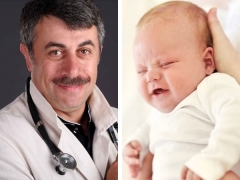E. Komarovsky about dysbacteriosis in a child
Theme dysbacteriosis in a child It is one of the most relevant for parents of both newborn babies and older children. Let's find out the opinion about this problem of the famous pediatrician Komarovsky.
What is dysbacteriosis?
According to Komarovsky, bacteria live in different places of the human body (in the nose, throat, vagina, lungs, intestines), and not alone, but in a certain combination, which is called microflora.
The name “dysbacteriosis” refers to any disruption of microflora, but since such a condition in the intestine develops most often, therefore, this concept is often referred to as intestinal dysbacteriosis.
The important role of intestinal microflora
A well-known doctor claims that dysbacteriosis is a common problem with a variety of symptoms. And so that parents can better understand why such a disease is relevant, it is necessary to understand the functions that bacteria perform in the human intestine. Among them:
- Participation in the synthesis of vitamins. Thanks to the activity of microorganisms, nicotinic and folic acids, B vitamins and vitamin K are formed.
- Ensuring gas exchange in the digestive tract.
- Assistance in the renewal of cells (their division) of the intestinal mucosa.
- Increased enzyme activity in the intestines.
- Assistance in the synthesis of amino acids.
- Participation in the metabolism of fatty acids, as well as uric acid and bile acids.
- Regulation of lymphoid cells (synthesis of lysozyme and immunoglobulins) in the intestine.
The most common causes of dysbiosis
According to Komarovsky, most often the appearance of dysbacteriosis leads to:
- Reception of medicines. Komarovsky notes that dysbiosis in the intestines leads not only antibiotics, but also the use of any other drugs and methods that suppress immunity.
- Power failure. Dysbacteriosis often develops with the abuse of sweets and fatty foods, as well as with the same diet and diets.
- Diseases of the digestive system (gastritis, colitis, ulcer, pancreatitis, duodenitis and others), as well as the operation performed on the gastrointestinal tract.
- Early lure. Too early acquaintance of a child with food unsuitable for him by age is a very common cause of dysbiosis in the first year of life.
- Intestinal infections and infection worms.

Recommendations
First of all, the popular doctor recalls that the concept of a norm in relation to microflora is very theoretical. Despite the fact that many studies have established normal indicators for the intestinal microflora, the ratio of bacteria changes under the influence of a huge number of factors - changes in diet, season, age and others. So dysbacteriosis is not always a disease, and if it is presented only by analysis on a piece of paper, and symptoms and complaints are absent, nothing needs to be treated.
The next thing Komarovsky warns about is that parents should not unreasonably resort to antibiotics. He notes that there are drugs that almost do not cause dysbiosis, for example, erythromycin or lincomycin. But there are also drugs, one tablet of which can disrupt the microflora in a child, for example, levomycetin or tetracycline.Only a doctor should prescribe a specific drug to a child.
Treatment
Treatment of dysbacteriosis Komarovsky calls difficult, for which the patient must have patience and punctuality, and the doctor - sufficient qualifications. It is a complex of diet and pharmacological agents, the choice of which is influenced by the type of disease, the cause of development, symptoms and test results. The main method of treatment is to receive eubiotics, but this is not the only type of treatment. Enzymes, bacteriophages, vitamins, and in some cases antibiotics can be prescribed to the child.
According to Komarovsky, it is quite simple to cure dysbacteriosis if it is possible to eliminate the cause of this pathology and the disease has developed not very long ago (less than six months). But in this case it is not worth counting on a very fast recovery.










